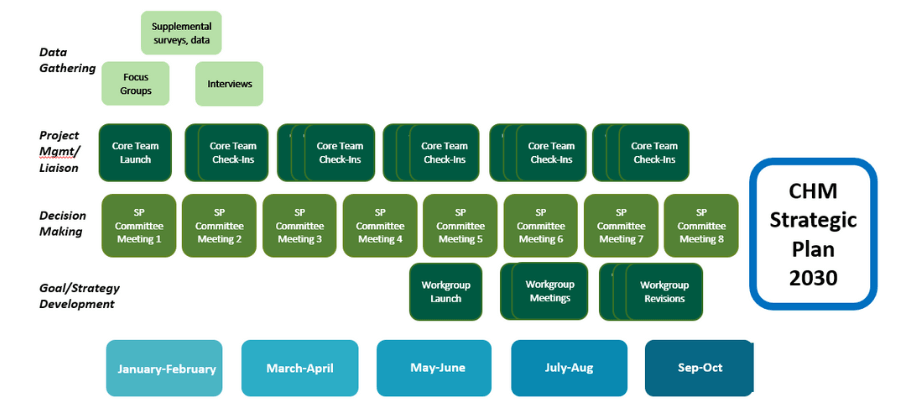Strategic Planning Process

The College of Human Medicine designed an inclusive strategic planning process with support from experienced external consultants HMA Community Strategies. The strategic plan was developed through a phased process of discovery, stakeholder engagement and strategy development. Each phase is briefly described below.
Discovery. The planning process began with the identification of a “core” planning team consisting of the dean, associate dean of administration and the executive director for academic affairs. Once identified, HMA consultants conducted a review of the college’s organizational documents, including past plans and materials about the college, as well as data relevant to college enrollment, demographic composition, and financial position. The desk review also included an environmental scan that included an examination of the college’s competitors and partners, and reports related to medical education and workforce development, research, and clinical practice.
To help steer the strategy work, the college formed a strategic planning committee to serve, which became the primary vehicles for discussion and presentation of ideas and recommendations. To form the committee, the dean’s office requested nominations for potential members. Twenty-eight (28) members were ultimately selected based on knowledge and experience with different aspects of the college. Members included students, staff, faculty, and a community member hailing from across different college campuses (14 were from East Lansing, 5 from Flint, 8 from Grand Rapids as well as members from Boyne and Traverse City). More than one-third (38%) of the committee identified as Black, Asian, or Latinx and 34% were non-faculty members (i.e., a student, staff, or community member).
Stakeholder Engagement. With input from the core team and members of the committee, HMA consultants conducted a series of focus groups and interviews draw in additional perspectives. Questions were developed collaboratively and based in part on a comprehensive SWOT analysis with committee membership who helped to surface issues for exploration early on in discussion. The college reached out to more than 30 potential stakeholders, including hospitals, university leadership, government officials and funding partners, and 20+ interviews were scheduled and conducted. In addition, HMA consultants conducted six focus groups with staff, students, and alumni. These included:
- A focus group with members of the Dean’s Staff Advisory Council
- A focus group faculty and staff focused on academics, recruitment, and retention
- A focus group with faculty and staff focused on the research enterprise
- Two focus groups with a mixture of 1st, 2nd, 3rd, and 4th year students
- A focus group with the College of Human Medicine’s Alumni Board

Strategy Development. The college used the strategic planning committee structure as the primary venue to consider and discuss strategy recommendations. From the start of the process to the end, the committee met eight times (seven times virtually 1.5-and 3-hour meetings and a half day in-person meeting in East Lansing). While the committee structure was the place where much of the discussion happened, the development of the goals, strategies and tactics was developed outside of the committee through planning workgroups. These included a workgroup focused on health equity and a grand challenge, a workgroup focused on staff and faculty affairs, a workgroup focused on student success and support, a workgroup focused on the college’s clinical enterprise, and a workgroup focused on research and college identity. These workgroups were comprised of both committee members and “extended members” who had additional or complementary skills or perspective to draw into the discussion. Workgroups developed goals and strategies, as well as preliminary activities and metrics, and presented their ideas to the planning committee. Feedback was incorporated and presented back to the committee in the form of a strategic framework with the support of HMA consultants.
A note of deep appreciation. This plan was only possible because of the time and commitment committed by the college’s staff, faculty and students and representatives from our community. The following pages identify the individuals who formally contributed to this plan either through service on the planning committed, the extended workgroup structure, or through an interview. (Note: it does not include all the individuals who participated in the focus groups).

